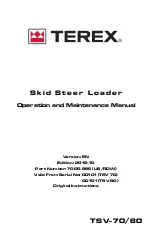
0
406
.GB
E 10
3.4
Safety restraint belt
The driver must check the operation and condition of the seat belt every day before
using the industrial truck. Faulty operation can only be detected in good time through
regular inspection.
F
Put on the safety restraint belt each time before starting the industrial truck.
The belt protects against serious injury.
Protect the belt from contamination (e.g. cover it when the truck is idle) and clean it
regularly. Frozen belt locks or pulleys must be thawed out and dried to prevent them
from freezing up again.
Z
The dry temperature of the warm air should not 60 °C.
F
Do not alter the belt setting.
This will increase the risk of malfunctioning.
– Always replace the safety restraint belt after an accident.
– Only original spare parts must be used for retrofits or repairs.
F
Damaged or non-operational belts must only be replaced by contractual dealers or
branches.
– Withdraw the belt completely and check the belt for possible fraying.
– Check the belt lock and make sure that the belt enters the retractor correctly.
Check the cover for damage
Testing the automatic blocking system:
– Park the truck in a horizontal position.
– Forcibly extract the belt.
M
The automatic system should lock the belt in the retractor.
– Open the engine bonnet approx. 30 degrees
M
The automatic system should lock the belt in the retractor.
Starting the industrial truck on steep slopes
The automatic blocking system locks the belt in the retractor when the truck is
positioned on a steep slope. This prevents the belt from being pulled out of the
retractor.
Z
Carefully drive the truck off the slope and then put on the belt.
Summary of Contents for DFG 316
Page 1: ...Operating instructions 51011137 DFG TFG 316 320 G 04 06 02 07...
Page 3: ...0108 GB...
Page 7: ...0406 GB I 4...
Page 9: ...0406 GB A 2...
Page 15: ...0207 GB B 6...
Page 17: ...0207 GB B 8...
Page 25: ...0207 GB B 16...
Page 29: ...0406 GB C 4...
Page 69: ...0406 GB E 36...
















































